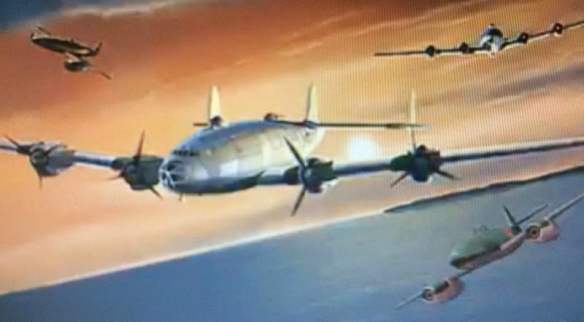
The Lockheed Model 249-58-01, officially designated XB-30, resembled a militarised Constellation from the outside, preserving the wings and tail of the commercial aircraft, but with a new fuselage and a glazed nose incorporating a bomb-aimer’s post, and with two bomb bays designed for eight 2000 lb bombs. It was to be defended by ten 12.5-mm machine guns and a 20-mm canon fitted in six remotely-controlled defensive turrets installed at the front and rear, and on top of the fuselage and beneath it, between the two bomb bays It had a twelve-man crew and was powered by four Wright R-3350-13 engines each developing 2200 bhp; the ‘super bomber’ was 140 ft long, with a wingspan of 123 ft and was to fly at more than 375 mph over 5000 miles with a 6160 Ib bomb load.
In January 1940 the USAAC issued the requirements for a super bomber with a speed of 400mph (640km/h), a range of 5,333 miles (8,850km) plus a bomb load of 2,0001b (900kg) that could be carried and dropped at the mid-point of the requested range. The official specification was revised in April to incorporate the lessons learned during the early days of the European war. The requested changes now included increased defensive armament, increased protective armour and self-sealing fuel tanks. This revision became the basis for Request for Data R-40B and Specification XC-2 L8. On 29 January 1940 the War Department formally issued Data R-40B, this being circulated to Boeing, Consolidated, Douglas and Lockheed. On 27 June 1940 the USAAC issued contracts for preliminary engineering data for the new super bomber to the four manufacturers, these being designated in order of preference as Boeing XB-29, Lockheed XB-30, Douglas XB-31 and Consolidated XB-32. The Lockheed XB-30 proposal envisaged a bomber powered by four Wright R-3350-13 air-cooled radials rated at 2,200hp. It was to have carried a crew of twelve in pressurized compartments. The wingspan had been 123fr(37,5m) with a length ofl04ft8in (JI. 9m). As Boeing had already completed much of the B-29 draughting and prototype mock-ups it was obvious that Lockheed were at a technical and competitive disadvantage, so the company withdrew its XB-30 proposal from the competition before any detailed designs could be completed. However, the work that Lockheed performed on the abortive XB-30 did not go to waste, since it was later put to use on the development of the C-69 Constellation transport.
General characteristics
Crew: 12
Length: 104 ft 8 in (31.91 m)
Wingspan: 123 ft 0 in (37.50 m)
Height: 23 ft 9 in (7.25 m)
Wing area: 1,646 ft2 (153 m2)
Empty weight: 51,616 lb (23,462 kg)
Loaded weight: 85,844 lb (39,020 kg)
Max. takeoff weight: 93,808 lb (42,640 kg)
Powerplant: 4 × Wright R-3350-13, 2,200 hp (1,600 kW) each
Performance
Maximum speed: 382 mph (615 km/h)
Range: 5,333 mi (8,045 km)
Service ceiling: 17,832 ft (5,440 m)
Rate of climb: ft/min (m/s)
Wing loading: 52 lb/ft2 (255 kg/m2)
Power/mass: 0.10 hp/lb (170 W/kg)
Armament
Guns:
8× .50 in (12.7 mm) machine guns in four fuselage turrets
2× .50 in (12.7 mm) machine guns and
1× 20 mm cannon in remotely aimed tail turret
Bombs: 16,000 lb